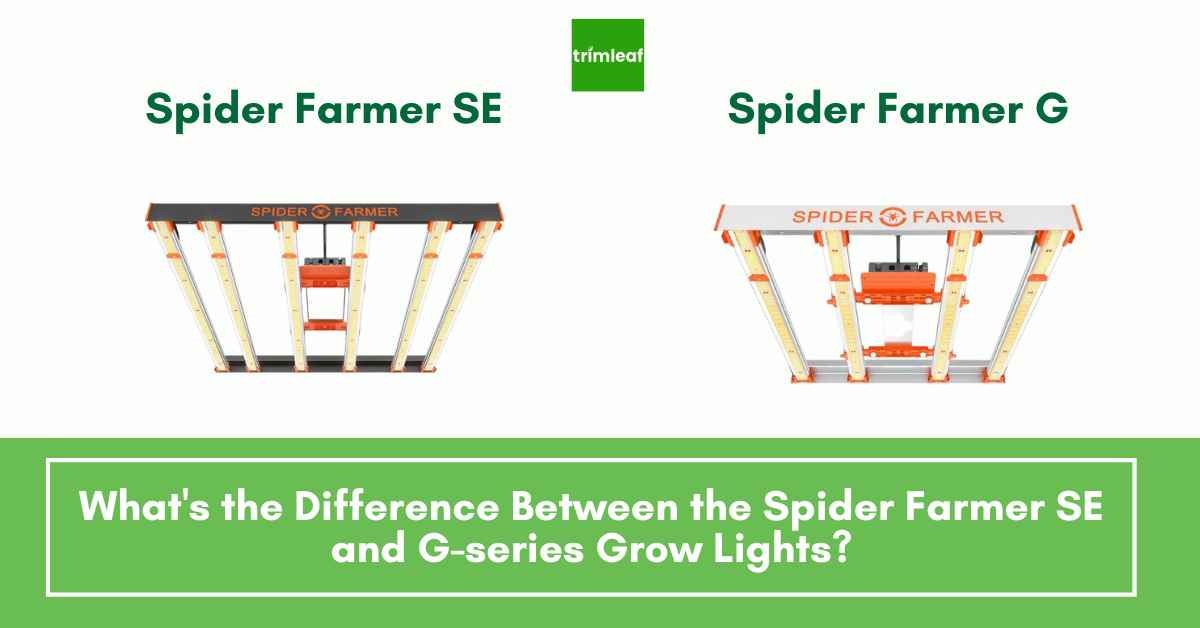
If you’re having a case of option paralysis with the Spider Farmer SE and G Series grow lights, this article is for you.
Spider Farmer developed the SE and G series grow lights to cater to different types of growers. While they have other specifications and ratings, both grow lights ensure efficiency to maximize your yields.
Before breaking down the differences between the SE and G series, let it be clear that one model is not necessarily better. The better choice will depend on your preferences.
Executive Summary
- The Spider Farmer SE and G Series grow lights differ in their chipset offering.
- The SE Series uses Samsung chipsets, while the G Series uses Bridgelux.
- The SE Series is a offered as premium grow light option with a higher price range ($400-1030) compared the G Series ($255-755), which is designed with price conscious users in mind.
- Both chipsets offer efficiency and are designed for maximum yields, with the SE series being slightly more efficient due to its chipset.
- The SE Series has a slightly higher PPFD than the G Series, but the difference is relatively small.
- It is important to consider other variables that would affect yield include lighting schedules, nutrient formulas, and growing environment.
- Experienced growers can still achieve high-quality yields with the G Series.
Differences Between the Spider Farmer SE & G-Series
*Specifications vary depending on the model
| Category | SE Series | G Series |
|---|---|---|
| Chipset | Samsung | Bridgelux |
| Number of Chips | 896 – 3710 | 896 – 4910 |
| PPE | 2.75 – 2.9 | 2.75 – 2.9 |
| PPFD | 829 – 2924 | 777 – 2955 |
| Price | $400 – 1,030 | $255 – 795 |
Chipsets
The chipsets used by these grow lights are the most prominent difference. The SE Series uses Samsung, while the G Series uses Bridgelux. These chipsets make a big difference between these grow lights. In fact, because of the type of chipset, there’s a big difference in the number of chips used. To go into detail, the SE Series uses 896 – 3710 LED chips, while G Series uses 896 – 4910 LED chips to cover the same functions as the SE.

The Samsung chipset used by SE uses low currents to drive it. It generates less heat yet can deliver light without burning out too fast. The Bridgelux also has a low current but is less efficient than the Samsung chipset. Because of this design, the G Series needs more LEDs to cover the needs. Their output and efficiency will also reveal a lot about their differences.

The SE and G Series both have the same PPE. However, when it comes to PPFD, the SE Series has a PPFD of 829 – 2924 umol/S, while the G Series has a PPFD of 777 – 2955. The difference is relatively small, yet for those very particular, these figures matter. Considering these differences, those looking for a particular PPFD should choose based on the wattage, going for the one closest to their needs.
Price
When it comes to price, the SE and G Series have a noticeable difference. The SE Series ranges from $400 – 1030, while the G Series costs $255 – 755. The SE Series is a premium grow light, while the G Series was designed with economic users in mind. At this point, the extra few hundred dollars you pay for the SE series gives you better efficiency. However, the economical choice in the G Series gives you more value for money.
Which Should You Buy?
Your preferences matter here. There’s not much difference in performance; the most significant deciding factor here is the chipset and the price. The G Series is a more logical choice if you’re looking to save money when buying a grow light. However, the SE Series is the way to go if you want a more efficient chipset. And remember that the chipset is just one factor in your indoor growing system. Remember that there are other considerations, such as lighting recipes, nutrient formulas, and the environment your plants are growing. In the hands of an abled or seasoned grower, even the G Series can produce high-quality yields during harvest time.




